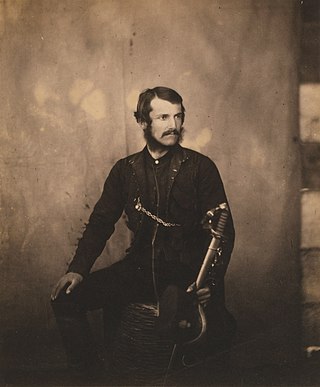
Aylestone is a suburb of Leicester, England, southwest of the city centre and east of the River Soar.

Hungarton is a small village and civil parish in the Harborough district, in the county of Leicestershire, England, about 10 miles (16 km) north-east of Leicester and 13 miles (21 km) south-west of Melton Mowbray. The population of the civil parish was 269 at the 2001 census, including Ingarsby, and increased to 289 at the 2011 census.
Andrew Burnaby was an English clergyman and travel writer, mainly about the American colonies and Italy.

Tolethope Hall in the parish of Little Casterton, Rutland, England, PE9 4BH is a country house near Stamford, Lincolnshire at grid reference TF023104. It is now the location of the Rutland Theatre of the Stamford Shakespeare Company. The hall is a Grade II* Listed Building,

Queniborough is an English village in the county of Leicestershire 2.5 miles (4 km) north-east of the town of Syston and of 7.5 miles (12 km) north-east of the city of Leicester. Its 972 properties housed 1,878 registered electors in 2003. The population increased to 2,326 at the 2011 census. It forms part of the Leicester Urban Area due to its proximity. The parish church of St Mary's has, according to the architectural historian Nikolaus Pevsner, "one of the finest spires in the whole of Leicestershire".

Beeby is a village and civil parish in the Charnwood district of Leicestershire, England, with a population of 115 according to the 2011 census. It is situated north-east of Leicester, nearer to the villages of Keyham and Hungarton in the neighbouring district of Harborough and lies along the Barkby Brook. This small rural hamlet can be succinctly described as "a series of scattered houses that remain of the shrunken medieval village". The parish also includes the hamlet of Little Beeby, which consists of several houses within the settlement and is located 200m south east of the All Saints Church.

South Croxton is a village and civil parish in the Charnwood district of Leicestershire, England. It had a population of 261 in the 2011 census. Nearby villages include Beeby, Barsby and Twyford.

Belgrave Hall is a Queen Anne-style Grade II* listed building in Belgrave. It is located on the northern edge of the city of Leicester.

Caroline Louisa Cavendish-Bentinck was the maternal grandmother of Queen Elizabeth The Queen Mother and a great-grandmother of Queen Elizabeth II.
Edwyn Burnaby of Baggrave Hall, Leicestershire, was an English landowner, courtier, a Justice of the Peace, Deputy Lieutenant, and High Sheriff of Leicestershire in 1864. He succeeded his father in the Court post of Gentleman of the Privy chamber. He was a maternal great-grandfather of Queen Elizabeth The Queen Mother and therefore a direct ancestor of Queen Elizabeth II and King Charles III.

Edwyn Sherard Burnaby was a major-general and Conservative Party Member of Parliament (MP) for Leicestershire North from 1880 until his death. He served in the Crimean War.

Ingestre Hall is a Grade II* 17th-century Jacobean mansion situated at Ingestre, near Stafford, Staffordshire, England. Formerly the seat of the Earls Talbot and then the Earls of Shrewsbury, the hall is now owned by Sandwell Metropolitan Borough Council and is in use as a residential arts and conference centre.

Burleigh Hall was a country house situated near Loughborough in the county of Leicestershire. Its land now forms part of the campus of Loughborough University.

Gaddesby Hall is an 18th-century brick-built house in the village of Gaddesby, Leicestershire. It was built in the late 1740s as a three-storey house with additions of 1868. It is a Grade II listed building.

Quenby Hall is a Jacobean house in parkland near the villages of Cold Newton and Hungarton, Leicestershire, England. It is described by Sir Nikolaus Pevsner as "the most important early-seventeenth century house in the county [of Leicestershire]". The Hall is Grade I listed, and the park and gardens Grade II, by English Heritage.
Stoughton Grange was a country house in the parish of Stoughton in Leicestershire and the family seat of the Farnham and Beaumont family. The house dated back to 15th century but was demolished in 1926, after being a successful family home for over five hundred years.

The Abbey of Saint Mary de Pratis, more commonly known as Leicester Abbey, was an Augustinian religious house in the city of Leicester, in the East Midlands of England. The abbey was founded in the 12th century by the Robert de Beaumont, 2nd Earl of Leicester, and grew to become the wealthiest religious establishment within Leicestershire. Through patronage and donations the abbey gained the advowsons of countless churches throughout England, and acquired a considerable amount of land, and several manorial lordships. Leicester Abbey also maintained a cell at Cockerham Priory, in Lancashire. The Abbey's prosperity was boosted through the passage of special privileges by both the English Kings and the Pope. These included an exemption from sending representatives to parliament and from paying tithe on certain land and livestock. Despite its privileges and sizeable landed estates, from the late 14th century the abbey began to suffer financially and was forced to lease out its estates. The worsening financial situation was exacerbated throughout the 15th century and early 16th century by a series of incompetent, corrupt and extravagant abbots. By 1535 the abbey's considerable income was exceeded by even more considerable debts.

Narborough Hall is a Grade II* listed building in Narborough in Leicestershire. Believed to date from 1596 this Elizabethan manor house was built by James Meade, a local landowner. However, it was only after it was extensively remodelled in the mid-19th century that it became known as Narborough Hall. It is notable because of its construction from local pink granite.

Bradgate House is a 16th-century ruin in Bradgate Park, Leicestershire, England.

Algernon Edwyn Burnaby of Baggrave Hall, Leicestershire, was an English landowner, soldier, and Justice of the Peace, and a cousin of Queen Elizabeth, the Queen Mother. He was Master of the Quorn Hunt.



















